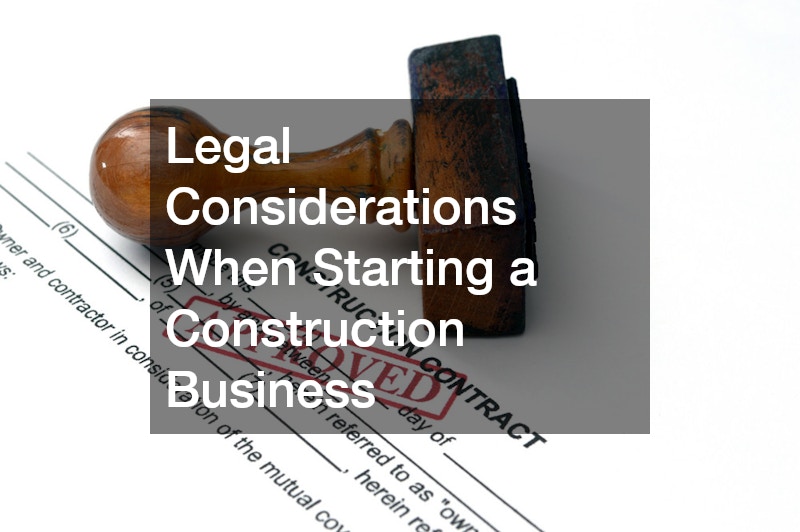Starting a construction business in Australia can be an exciting and rewarding endeavour. However, it involves more than just building structures or managing blueprints. Construction entrepreneurs must navigate a complex legal landscape to protect their company, employees, and clients. Failure to address these legal considerations can lead to costly penalties, disputes, or even the closure of the business. This article explores ten key legal concerns every Australian construction business owner should address to minimise risk, ensure compliance, and build a strong foundation for success.
1. What Are the Licensing Requirements for a Construction Business?
One of the first steps to starting a construction business in Australia is obtaining the appropriate licences. Licences ensure that contractors meet regulatory and professional standards.
A. Understanding Local and State Licensing Laws
Licensing requirements vary across Australian states and territories. For instance, in New South Wales, the Fair Trading office regulates contractor licensing, while in Queensland, the Queensland Building and Construction Commission (QBCC) oversees the process. Each state may have specific requirements for electricians, plumbers, and general builders. Consulting with a solicitor specialising in construction law can help you navigate these complexities.
B. How to Obtain the Necessary Permits
Construction permits are essential for individual projects. Failure to secure the right permits can result in fines, project delays, or legal action.
C. Common Mistakes in Licensing Applications
Mistakes such as incomplete applications or missing documentation can slow down the process. Working with an experienced legal or administrative team can help streamline your applications.
D. Contractor Licence Renewals and Continuing Education
In Australia, many licences require periodic renewal, and continuing professional development (CPD) is often mandatory to stay updated with industry standards and regulations.
E. Penalties for Non-Compliance
Operating without the required licences can result in heavy fines, revoked permits, or even criminal charges. For example, crane operators must ensure regular inspections to avoid compliance issues and fines.
2. How Can I Protect My Business with Construction Contracts?
Clear and enforceable contracts are critical in the construction industry to define project scope, payment terms, and legal obligations.
A. Key Clauses in Construction Contracts
Essential clauses include payment schedules, dispute resolution mechanisms, and indemnity clauses to protect you from liability arising from workplace injuries.
B. Tailoring Contracts for Specific Projects
Every construction project is unique. Customising contracts for each project minimises ambiguity and potential disputes.
C. Dispute Resolution Options
Including mediation or arbitration clauses can help avoid costly litigation in case of disputes.
D. Aligning Contracts with Client Expectations
Contracts should clearly outline deliverables, timelines, and costs to manage client expectations effectively.
E. Legal Actions for Breach of Contract
Understanding your legal options when a client breaches a contract can save time and resources. Always seek legal advice before pursuing action.
3. What Are the Insurance Needs for a Construction Business?
Insurance is a cornerstone of risk management in the construction industry. Being underinsured can expose your business to significant liabilities.
A. Types of Insurance Coverage
Common insurance policies include public liability insurance, worker’s compensation, professional indemnity insurance, and builder’s risk insurance.
B. Evaluating Your Risk Profile
The size and nature of your projects, the equipment you use, and the number of employees you have will determine your insurance needs.
C. Choosing the Right Insurance Provider
Select an insurer familiar with the construction industry to tailor coverage to your specific requirements.
D. Streamlining the Insurance Claim Process

Having a clear process for lodging and managing claims can minimise downtime after accidents or property damage.
E. Legal Implications of Underinsurance
Inadequate coverage could leave your business vulnerable to lawsuits and liability for personal assets, jeopardising its survival.
4. How Do Zoning Laws Affect Construction Business Operations?
Zoning regulations dictate land use and can significantly impact your construction projects. Ignoring these laws can lead to penalties, delays, or project cancellations.
A. Navigating Zoning Regulations
Zoning laws vary by local councils. For instance, a residential zone may restrict commercial developments. Consulting a solicitor experienced in land use laws can help you avoid non-compliance.
B. Handling Zoning Changes
Zoning changes due to environmental concerns or community needs can disrupt approved projects. Monitoring local council updates can help you adapt proactively.
C. Applying for Zoning Variances
When projects conflict with existing zoning laws, you may need to apply for a variance. Legal support can strengthen your case during public hearings.
D. Engaging with the Community
Building community trust through consultations and information sessions can reduce opposition to your project.
E. Consequences of Zoning Violations
Non-compliance can result in fines, legal action, or demolition orders. Keeping detailed records of permits and approvals is crucial.
5. What Employment Laws Must Be Followed in the Construction Industry?
Construction employers must comply with Australian labour laws to ensure worker safety and fair treatment.
A. Wage and Award Compliance
Ensure compliance with Australian wage awards and enterprise agreements to meet minimum pay standards.
B. Health and Safety Obligations
Workplace health and safety (WHS) training, such as working at heights and asbestos handling, is not only good practice but often mandatory.
C. Anti-Discrimination Practices
Avoid discriminatory hiring practices to prevent legal action.
D. Correct Classification of Workers

Properly classify employees and contractors to avoid tax and superannuation complications.
E. Managing Workplace Disputes
Seek advice from legal experts for handling disputes, especially those involving workplace injuries.
6. How Do Environmental Laws Impact Construction Projects?
Compliance with environmental laws is essential to avoid fines, project delays, or reputational damage.
A. Conducting Environmental Impact Assessments
Assess potential environmental impacts and develop mitigation plans to ensure compliance.
B. Adhering to Clean Air and Water Standards
Construction sites must manage pollution and waste disposal in line with federal and state laws.
C. Managing Hazardous Materials
Improper disposal of hazardous waste can lead to severe penalties.
D. Green Building Standards
Adopting green building codes can improve compliance and enhance your reputation for sustainability.
E. Consequences of Non-Compliance
Environmental breaches can result in legal actions, project shutdowns, and reputational harm.
7. What Are the Intellectual Property Issues in Construction?
Intellectual property (IP) is an often-overlooked aspect of construction but can be critical for innovative businesses.
A. Patenting Unique Methods and Materials
Patents can protect proprietary building methods and materials from competitors.
B. Protecting Architectural Designs
Copyright laws safeguard original designs from unauthorised use.
C. Trademarking Your Brand
A registered trademark helps distinguish your business and prevents brand infringement.
D. Resolving IP Disputes
Seek legal advice to manage IP disputes effectively.
E. Using Licensed Technology
Ensure compliance when using licensed software and technology to avoid legal risks.
8. What Legal Considerations Exist for Using Subcontractors?
Subcontractors are vital to construction projects but managing them requires attention to legal details.
A. Drafting Subcontractor Agreements
Clearly define scope, payment terms, and dispute resolution mechanisms in contracts.
B. Verifying Subcontractor Compliance
Ensure subcontractors meet licensing and insurance requirements.
C. Legal Liability for Subcontractor Misconduct
You may be held liable for subcontractors’ negligence or non-compliance.
D. Managing Payments and Lien Rights
Transparent payment processes reduce the risk of disputes.
E. Establishing Quality Control
Set clear quality expectations to avoid conflicts.
9. How Do Construction Bonds Work?
Construction bonds provide financial security to clients and demonstrate your business’s reliability.
A. Types of Bonds
Common bonds include bid bonds, performance bonds, and payment bonds.
B. Benefits of Bonding
Bonds enhance trust and provide financial protection in case of project issues.
C. Managing Bond Claims
Understanding the claims process can minimise financial risks.
By addressing these legal considerations, Australian construction business owners can minimise risks, comply with regulations, and build a solid foundation for success.
